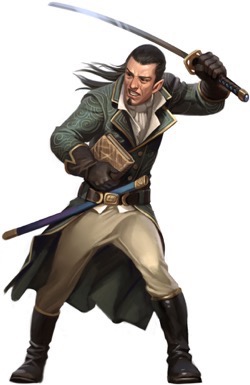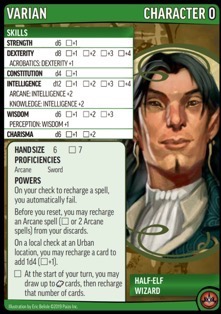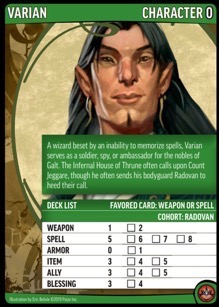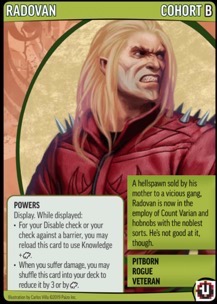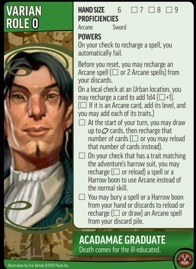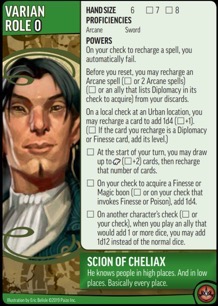Keith and Shannon have been talking about the new character designs in the Pathfinder Adventure Card Game Core Set, so I thought I would do some blogs about the characters from the Curse of the Crimson Throne Adventure Path. In particular, today I’m going to consider Varian Jeggare, everyone’s favorite faithful Chelaxian Wizard dedicated to Asmodeus.
Those of you who are familiar with Varian, whether from the Pathfinder Society, the Pathfinder Tales Character Deck, Keith’s previous blog post about that deck, or from any of Dave Gross’s novels featuring Varian, will recognize that I might have, ahem, stretched the truth a bit in that last paragraph. If that sounds interesting to you, I can enthusiastically recommend any of those sources for more detail. For now, I’m going to dig a bit deeper into the design of Varian as a PACG character.
When the time came for us to put together a set of characters for Curse, we knew that we’d want to play up the connection between the characters and the city of Korvosa itself, so Varian went on the list early. In addition to being a cool and familiar character that hadn’t yet appeared in an Adventure Path, he’s a graduate of the Acadamae in Korvosa and he’s a noble with interesting connections to Cheliax, Asmodeus, and Desna. The early drafts of his character wanted to establish him as a wizard (mostly… more on that later), a bit of a fencer, and a well-connected man-about-town.
Varian’s hardly a hulking, brutish sort (if that’s your thing, check his cohort Radovan), so we didn’t want him to rely on Strength, but we still wanted him to be capable in Melee. We were planning on pushing him toward Finesse-style weapons, so we counted on being able to give him a skill to help. This ended up as Acrobatics: Dexterity and Sword proficiency, which helps keep him true to Dave Gross’s original concept without too much card-text overhead. This approach also made him a good potential fit for—avoiding spoilers here—an option that comes up during the AP. As a “gentleman of means and connections,” we gave him a power that adds a bonus to efforts (his or others) wherever he could reasonably call on civilized aid. This melded nicely with the new traits we’d added to locations. So Varian can call for help in Urban locations, where his name, rank, manners, money, and/or general confidence can be put to use. Naturally enough, this makes Varian want to spend his time in those locations.
Since Varian is a wizard, he has a strong Arcane skill, but with his particular take on wizardry, we wanted him to feel distinct from Ezren or Darago during play. Since the Core Set was moving away from “if you have the Arcane skill” toward proficiency as the method to determine whether or not spells were used as if prepared from a book or as one-shot scrolls, we could simply give him proficiency with Arcane to keep the spells after using them. To create the “riffle scrolls” effect (see Pathfinder Campaign Setting: Inner Sea Magic for more details) that allows Varian to avoid the debilitating nausea that besets him when casting spells, we gave him an unusual power: Unlike Seoni who automatically succeeds at recharging Arcane spells, or Ezren who is very likely to succeed, Varian automatically fails. This gets those boons into his discard pile where his next character power lets him pull them to the bottom of his deck.
Finally, we come to Varian’s fourth character power, one that requires a feat. This power lets him draw some cards and then recharge the same number of cards, so he stays at the same number of cards in hand, but he gets to choose which he keeps and which he stores away for later. All by itself, this filtering power is useful on both ends: it can help you get a key card that’s hiding in your deck, and it can also let you save cards that are good but not yet needed, or not safe sitting in your hand. This power is a bit more mechanical than some others; to me, it generally represents Varian’s resourcefulness, and it also combines with his riffle scrolls power to help him manage which spells he wants now versus which spells he wants later. This gets us to the not-so-secret direction that I wanted for Varian: deck control. It would take too long to explain, so I’ll try to sum up. You see, it’s all Paizo’s fault. To be more specific: it’s PaizoCon’s fault.
Late in the wee hours one PaizoCon night, Keith and I were watching and playing an early Core playtest. Who did which has been lost to sleeplessness, but what’s important here is that someone was playing an Arcane caster, and they were playing it by counting their deck.
Since the early days of PACG, we’ve seen people dedicate a lot of attention to managing their deck. While most Divine casters tend to heal themselves to victory—hi, Paul!—other early characters like Valeros and Sajan also get in on the recharging game, especially when combined with a little judicious deck thinning.
Deck thinning, for those who don’t already know, is the process of specifically (and, hopefully, carefully) removing cards from your deck so that it’s more likely to produce the cards you really want. Valeros can thin his deck to his favorite weapons (or those most appropriate to the current scenario) and then make repeated use of his power to recharge them. If Sajan can get rid of his items and allies, then his deck is focused down to a big pile o’ blessings, which he can recharge for big hits. The downside of this approach is the danger. In addition to the utility of the specific cards you give up, you also have to sacrifice your “hit point buffer” to get there. For example, when Rise the Runelords Sajan’s deck is thinned down to his 10 blessings, he’s very strong at combat checks, but if he’s forced to discard 4 of them to damage, suddenly those boons he “got out of the way” would be very helpful to have around.
Even people who don’t push things quite so far can derive fun and benefit from managing what cards they recharge and when. This sort of deck manipulation is especially common among characters like Ezren and Seoni who cast a lot of spells, and usually get to recharge them. What I saw that night/morning at PaizoCon was someone who wasn’t just thinning their deck; they were working to set it up, ordering and recharging cards to the bottom to try to plan their future draws, setting themselves up to be ready for the future, for other people’s turns and their own. While this sort of play isn’t for everyone, both that player and the rest of the table seemed to be enjoying themselves. I always enjoy watching people really get into the game, whether it be the story, characters, theme, mechanics, or anything else. With Varian, I was trying to build a character for this sort of player. For the person who shuffles their deck, draws their starting hand, and then proceeds to exert order over the chaos of the game, choosing what to recharge, when, and in what order. For the person that knows when they want to be healed, and especially when they don’t want to be healed, because they know when the card they want is coming up, and they don’t want you messing with their order. I’ll say it again: it’s not for everyone, but in the right hands, it’s a beautiful thing.
As Varian well knows, it’s always good to have friends. Also: companions, suitors, contacts, servants, agents, employees, and factotums. In this case, Varian has his personal “bodyguard” Radovan Virholt, and he’s quite lucky to do so. Radovan will stick around Varian to protect him from harm, and while he’s around, the two of them can be quite effective at solving “problems,” including problems you might not expect to be solved by a gentleman fencer. When Radovan does have to temporarily deal with a dangerous situation, Varian’s ability to draw and recharge will help get Radovan back by Varian’s side.
When Varian gains a role card, one option is to lean into his studies as an Acadamae Graduate. This lets him get even more benefit “around town” from his contacts that are interested in the Arcane arts. He can also filter cards to the top or bottom of his deck for even more control. Finally, his time at the Acadamae lets him call on his studies of magic and the Harrow, both to get out of unusual situations (using Arcane instead of another skill), and also to dig deep for a crucial spell in a moment of need.
Varian’s other option in Curse of the Crimson Throne leans into his political, diplomatic, and noble connections, as well as his fencing studies *cough* spoilers avoided *cough*. Always one to make friends and (try to) influence people, Varian can now make even greater use of his allies, both their inherent abilities and for “favors.” He can also get flashy with his rapier (or, I suppose, other, less gentlemanly weapons) to good effect. One of the powers represents some lessons that we think he might have picked up from his friend Radovan (I’ll bet you can guess which one!), or perhaps just the influence of his officious dedication to his official religion. Finally, neither last (on his role card) nor least (for my not-so-secret intentions), his “resourcefulness” ability can be extended to a large degree, especially late in the Adventure Path. Put another way, even if “deckmaster” isn’t your thing, I’ll bet you can find ways to enjoy drawing essentially a second full hand at the start of each turn, then putting a fistful of cards back for later, and in the order you think you might want them.
For those of you who might be looking to try out Varian for the first time, we’ve put together a set of deck suggestions for Varian using cards from the Curse of the Crimson Throne Adventure Path.
- Weapon: Scimitar
- Spells: Acid Burst, False Life, Infernal Healing, 2 others
- Item: Spellbook, 2 others
- Ally: Acadamae Student, 2 others
- Blessing: any 3
That’s it for now; I hope you enjoyed this look behind the curtain at Varian. If you’d like more or less of this sort of thing, please do let us know in the comments. Thanks!
Chad Brown
Adventure Card Game Lead Developer

